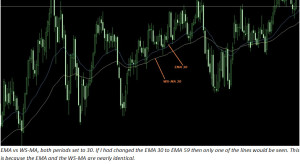Wilder’s Smoothing Tool – As Smooth As It Sounds!
Full Review of Wilder’s Smoothing Indicator for Binary Options Trading
Ever heard of Welles Wilder? Correct, Wilder is the creator of many famous technical tools, his most commonly used is the Relative Strength Index, RSI. Welles Wilder is also the author of the book “New Concepts in Technical Trading Systems”, published back in 1978, which is totally worth reading if you really want to deepen your understanding about how all of his indicators are calculated and work. What’s in focus today is Wilder’s Smoothing indicator, also called the modified moving average. An easy to use, simply calculated and comprehensible tool – but is it any good and how should you use it if it is? Let’s see whether it’s as smooth as it sounds!
What Is Wilder’s Smoothing Indicator?
Wilder’s Smoothing indicator is basically a moving average, very similar to the popular exponential moving average which is used for identifying trends. In fact, by adding 1 to an EMA period and then dividing the sum by 2 you will get the value that is equivalent to Wilder’s Smoothing Moving Average. For example: EMA 49 is a 25 WS-MA or EMA 99 is a WS-MA 50. Basically, if you are using a 100 period EMA you are almost using a 50 period WS-MA! Insert both indicators and you’ll see what I mean. You can find Wilder’s Smoothing MA in MetaTrader 4, click insert, indicators, Trend, Moving Average and set the MA method to ‘Smoothed’, the EMA is there too. Traders use this tool to confirm the direction of the trend. If candlesticks are closing above the WS-MA, the trend is bullish. Candlesticks closing below the WS-MA confirms a bearish trend.
Now you must be wondering which of the moving averages you should choose. As I mentioned above, the EMA and the WS-MA are the same even though the method of calculation differs between them, therefore, it doesn’t matter which one you choose. You can read more about a moving average performance test here, they came to the same conclusion: EMA = WS-MA. The WS-MA performs best when set to lower periods. In the test linked above, they concluded that a 30 WS-MA was the best period and that periods above 45 made the accuracy drop significantly. I plotted the 30 WS-MA and I completely agree with their results. A 30 WS-MA looks very great on higher time frames, H4, Daily and above. However, you should lower the period for time frames below H4. I recommend using this indicator along with other indicators to verify its signals, RSI and Stochastic are good choices for example.

Why Does Wilder’s Smoothing Indicator Suck?
This indicator does not perform well when its period is increased. Then again, you might not need to use higher periods than 30 days for trading binary options. So whether this is a drawback or not depends on how you want to use it. Furthermore, the indicator can be lagging in responding to price change. That’s why it shouldn’t be used alone.
Why Doesn’t Wilder’s Smoothing Indicator Suck?
It doesn’t suck because it does what it’s supposed to, which is showing the direction of the trend. The indicator is easy to understand, all you have to do is to keep an eye on where the candles are closing, above or below the line. It’ll perform even better when combined with other indicators. In the test mentioned earlier, the 30 period WS-MA outperformed some of the other indicators when used for taking end of week signals.
Conclusion – Sweet Smoothies!
Knowing the direction of the trend can be what decides whether you win or lose the next trade. Using Wilder’s Smoothing MA with other indicators such as the RSI, a leading indicator and drawing some trend lines will give this indicator the extra boost it needs to become an important tool in your strategy. Obviously, you can use an EMA instead – since they are almost the same. But hey, no one said you can’t use both of them together! You can use a WS-MA 30 period along with an EMA 200 period if you like – or ANY other period that suits your trading style and time frame as crossovers can produce good signals too. In conclusion: it is recommended to have at least one indicator that helps signals when using this tool.